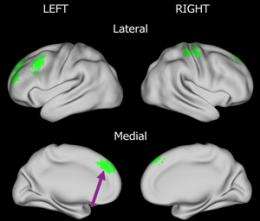Researchers study children at risk for Tourette syndrome

(PhysOrg.com) -- Neuroscientists at Washington University School of Medicine in St. Louis are using sophisticated imaging, neuropsychological testing and clinical evaluations to study children who may be at risk for Tourette Syndrome (TS) due to the onset of motor and/or vocal tics.
“As many as 20 to 30 percent of children develop tics at some time in their life, and typically, these tics disappear in a few months,” says Kevin J. Black, MD, professor of psychiatry, of neurology, of neurobiology and of radiology. “But for about 3 percent of children, those new tics represent the beginnings of either Tourette Syndrome or a condition known as Chronic Tic Disorder.”
Movies, television shows and other popular media presentations tend to portray people with TS as whooping, shuddering or cursing uncontrollably, but the syndrome often is much more subtle, according to Black. More common tics include head shaking, excessive blinking and repeated sniffing.
When a child develops tics, doctors typically advise parents not to worry since the tics likely will go away, according to Black. But why most tics disappear while others remain is not well understood, so Black and postdoctoral research associate Deanna Greene, PhD, are studying children who recently have developed tics.
They will use MRI scans to measure brain volumes and brain function in these children. The children will be followed for one year. Those who still have tics after a year may be diagnosed with TS, which requires both movement and vocal tics for at least a year. If tics are still present after a year but no vocal tics have developed, it is called Chronic Motor Tic Disorder.
The researchers then will be able to compare function and anatomy in the brains of those children to brain function and brain anatomy in children whose tics go away after a few months.
“By comparing what we find in those whose tics persist with those whose tics remit, we hope to identify biomarkers that help predict whether recent-onset tics are likely to go away or to persist and develop into Tourette’s,” Black says.
To enroll in the study, children cannot have had tics for more than three months. Because other studies have suggested that certain clinical measures can predict poor long-term outcomes in children with tics, the research team will do clinical testing, IQ testing and measure the child’s manual dexterity and current symptom severity.
Besides receiving MRI brain scans, participants in the study will be evaluated at the start of the study period, and then three months later and 12 months after the first appearance of tics. Follow-up examinations will involve clinical tests but won’t include MRI scans.











